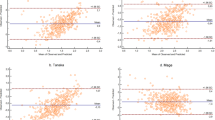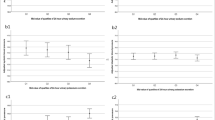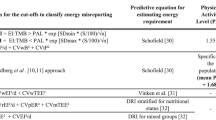Abstract
Measurement error in assessment of sodium and potassium intake obscures associations with health outcomes. The level of this error in a diverse US Hispanic/Latino population is unknown. We investigated the measurement error in self-reported dietary intake of sodium and potassium and examined differences by background (Central American, Cuban, Dominican, Mexican, Puerto Rican and South American). In 2010–2012, we studied 447 participants aged 18–74 years from four communities (Miami, Bronx, Chicago and San Diego), obtaining objective 24-h urinary sodium and potassium excretion measures. Self-report was captured from two interviewer-administered 24-h dietary recalls. Twenty percent of the sample repeated the study. We examined bias in self-reported sodium and potassium from diet and the association of mismeasurement with participant characteristics. Linear regression relating self-report with objective measures was used to develop calibration equations. Self-report underestimated sodium intake by 19.8% and 20.8% and potassium intake by 1.3% and 4.6% in men and women, respectively. Sodium intake underestimation varied by Hispanic/Latino background (P<0.05) and was associated with higher body mass index (BMI). Potassium intake underestimation was associated with higher BMI, lower restaurant score (indicating lower consumption of foods prepared away from home and/or eaten outside the home) and supplement use. The R2 was 19.7% and 25.0% for the sodium and potassium calibration models, respectively, increasing to 59.5 and 61.7% after adjusting for within-person variability in each biomarker. These calibration equations, corrected for subject-specific reporting error, have the potential to reduce bias in diet–disease associations within this largest cohort of Hispanics in the United States.
This is a preview of subscription content, access via your institution
Access options
Subscribe to this journal
Receive 12 digital issues and online access to articles
$119.00 per year
only $9.92 per issue
Buy this article
- Purchase on Springer Link
- Instant access to full article PDF
Prices may be subject to local taxes which are calculated during checkout



Similar content being viewed by others
References
Cogswell ME, Zhang Z, Carriquiry AL, Gunn JP, Kuklina EV, Saydah SH et al. Sodium and potassium intakes among US adults: NHANES 2003-2008. Am J Clin Nutr 2012; 96 (3): 647–657.
Zhang Z, Cogswell ME, Gillespie C, Fang J, Loustalot F, Dai S et al. Association between usual sodium and potassium intake and blood pressure and hypertension among U.S. adults: NHANES 2005-2010. PLoS ONE 2013; 8 (10): e75289.
Fulgoni VL 3rd, Agarwal S, Spence L, Samuel P . Sodium intake in US ethnic subgroups and potential impact of a new sodium reduction technology: NHANES Dietary Modeling. Nutr J 2014; 13 (1): 120.
Freedman LS, Commins JM, Moler JE, Willett W, Tinker LF, Subar AF et al. Pooled results from 5 validation studies of dietary self-report instruments using recovery biomarkers for potassium and sodium intake. Am J Epidemiol 2015; 181 (7): 473–487.
Alderman MH . Evidence relating dietary sodium to cardiovascular disease. J Am Coll Nutr 2006; 25 (3 Suppl): 256s–261ss.
Graudal NA, Hubeck‐Graudal T, Jurgens G . Effects of low‐sodium diet vs high‐sodium diet on blood pressure, renin, aldosterone, catecholamines, cholesterol, and triglyceride (Cochrane review). Am J Hypertens 2012; 25 (1): 1–15.
Levings J, Cogswell M, Curtis CJ, Gunn J, Neiman A, Angell SY . Progress toward sodium reduction in the United States. Rev Panam Salud Publica 2012; 32 (4): 301–306.
Murakami K, Livingstone MB, Sasaki S, Uenishi K . Ability of self-reported estimates of dietary sodium, potassium and protein to detect an association with general and abdominal obesity: comparison with the estimates derived from 24 h urinary excretion. Br J Nutr 2015; 113 (8): 1308–1318.
Kieneker LM, Gansevoort RT, de Boer RA, Brouwers FP, Feskens EJ, Geleijnse JM et al. Urinary potassium excretion and risk of cardiovascular events. Am J Clin Nutr 2016; 103 (5): 1204–1212.
Cogswell ME, Mugavero K, Bowman BA, Frieden TR . Dietary sodium and cardiovascular disease risk—measurement matters. N Engl J Med 2016; 375 (6): 580–586.
Sacks FM, Svetkey LP, Vollmer WM, Appel LJ, Bray GA, Harsha D et al. Effects on blood pressure of reduced dietary sodium and the Dietary Approaches to Stop Hypertension (DASH) diet. DASH-Sodium Collaborative Research Group. N Engl J Med 2001; 344 (1): 3–10.
Tinker LF, Sarto GE, Howard BV, Huang Y, Neuhouser ML, Mossavar-Rahmani Y et al. Biomarker-calibrated dietary energy and protein intake associations with diabetes risk among postmenopausal women from the Women's Health Initiative. Am J Clin Nutr 2011; 94 (6): 1600–1606.
Prentice RL, Shaw PA, Bingham SA, Beresford SA, Caan B, Neuhouser ML et al. Biomarker-calibrated energy and protein consumption and increased cancer risk among postmenopausal women. Am J Epidemiol 2009; 169 (8): 977–989.
Prentice RL, Mossavar-Rahmani Y, Huang Y, Van Horn L, Beresford SA, Caan B et al. Evaluation and comparison of food records, recalls, and frequencies for energy and protein assessment by using recovery biomarkers. Am J Epidemiol 2011; 174 (5): 591–603.
Mercado CI, Cogswell ME, Valderrama AL, Wang CY, Loria CM, Moshfegh AJ et al. Difference between 24-h diet recall and urine excretion for assessing population sodium and potassium intake in adults aged 18-39 y. Am J Clin Nutr 2015; 101 (2): 376–386.
Freedman LS, Midthune D, Carroll RJ, Krebs-Smith S, Subar AF, Troiano RP et al. Adjustments to improve the estimation of usual dietary intake distributions in the population. J Nutr 2004; 134 (7): 1836–1843.
Holbrook JT, Patterson KY, Bodner JE, Douglas LW, Veillon C, Kelsay JL et al. Sodium and potassium intake and balance in adults consuming self-selected diets. Am J Clin Nutr 1984; 40 (4): 786–793.
McCullough ML, Swain JF, Malarick C, Moore TJ . Feasibility of outpatient electrolyte balance studies. J Am Coll Nutr 1991; 10 (2): 140–148.
Clark AJ, Mossholder S . Sodium and potassium intake measurements: dietary methodology problems. Am J Clin Nutr 1986; 43 (3): 470–476.
Cogswell ME, Elliott P, Wang CY, Rhodes DG, Pfeiffer CM, Loria CM . Assessing U.S. sodium intake through dietary data and urine biomarkers. Adv Nutr 2013; 4 (5): 560–562.
Turban S, Miller ER 3rd, Ange B, Appel LJ . Racial differences in urinary potassium excretion. J Am Soc Nephrol 2008; 19: 1396–1402.
Brown IJ, Dyer AR, Chan Q, Cogswell ME, Ueshima H, Stamler J et al. Estimating 24-hour urinary sodium excretion from casual urinary sodium concentrations in Western populations: the INTERSALT study. Am J Epidemiol 2013; 177 (11): 1180–1192.
Huang Y, Van Horn L, Tinker LF, Neuhouser ML, Carbone L, Mossavar-Rahmani Y et al. Measurement error corrected sodium and potassium intake estimation using 24-hour urinary excretion. Hypertension 2014; 63 (2): 238–244.
Sorlie PD, Aviles-Santa LM, Wassertheil-Smoller S, Kaplan RC, Daviglus ML, Giachello AL et al. Design and implementation of the Hispanic Community Health Study/Study of Latinos. Ann Epidemiol 2010; 20 (8): 629–641.
Lavange LM, Kalsbeek WD, Sorlie PD, Aviles-Santa LM, Kaplan RC, Barnhart J et al. Sample design and cohort selection in the Hispanic Community Health Study/Study of Latinos. Ann Epidemiol 2010; 20 (8): 642–649.
Mossavar-Rahmani Y, Shaw PA, Wong WW, Sotres-Alvarez D, Gellman MD, Van Horn L et al. Applying recovery biomarkers to calibrate self-report measures of energy and protein in the Hispanic Community Health Study/Study of Latinos. Am J Epidemiol 2015; 181 (12): 996–1007.
Subar AF, Midthune D, Tasevska N, Kipnis V, Freedman LS . Checking for completeness of 24-h urine collection using para-amino benzoic acid not necessary in the Observing Protein and Energy Nutrition Study. Eur J Clin Nutr 2013; 67 (8): 863–867.
Hoos T, Espinoza N, Marshall S, Arredondo EM . Validity of the Global Physical Activity Questionnaire (GPAQ) in adult Latinas. J Phys Act Health 2012; 9 (5): 698–705.
Neuhouser ML, Tinker L, Shaw PA, Schoeller D, Bingham SA, Horn LV et al. Use of recovery biomarkers to calibrate nutrient consumption self-reports in the Women's Health Initiative. Am J Epidemiol 2008; 167 (10): 1247–1259.
Anderson CA, Appel LJ, Okuda N, Brown IJ, Chan Q, Zhao L et al. Dietary sources of sodium in China, Japan, the United Kingdom, and the United States, women and men aged 40 to 59 years: the INTERMAP study. J Am Diet Assoc 2010; 110 (5): 736–745.
Bernstein AM, Willett WC . Trends in 24-h urinary sodium excretion in the United States, 1957-2003: a systematic review. Am J Clin Nutr 2010; 92 (5): 1172–1180.
Yi SS, Curtis CJ, Angell SY, Anderson CA, Jung M, Kansagra SM . Highlighting the ratio of sodium to potassium in population-level dietary assessments: cross-sectional data from New York City, USA. Public Health Nutr 2014; 17 (11): 2484–2488.
Trijsburg L, de Vries JH, Boshuizen HC, Hulshof PJ, Hollman PC, van 't Veer P et al. Comparison of duplicate portion and 24h recall as reference methods for validating a FFQ using urinary markers as the estimate of true intake. Br J Nutr 2015; 114 (8): 1304–1312.
Acknowledgements
The Study of Latinos: Nutrition and Physical Activity Assessment Study was supported by grant R01HL095856 from the National Heart, Lung, and Blood Institute. The Hispanic Community Health Study/Study of Latinos was carried out as a collaborative study supported by contracts from the National Heart, Lung, and Blood Institute to the University of North Carolina (N01-HC65233), University of Miami (N01-HC65234), Albert Einstein College of Medicine (N01-HC65235), Northwestern University (N01-HC65236) and San Diego State University (N01-HC65237). The following Institutes/Center/Offices contribute to the Hispanic Community Health Study/Study of Latinos through a transfer of funds to the National Heart, Lung, and Blood Institute: the National Center on Minority Health and Health Disparities, the National Institute of Deafness and Other Communications Disorders, the National Institute of Dental and Craniofacial Research, the National Institute of Diabetes and Digestive and Kidney Diseases, the National Institute of Neurological Disorders and Stroke, and the Office of Dietary Supplements. Additional support at the Albert Einstein College of Medicine was provided from the Clinical & Translational Science Award (UL1 TR001073) from the National Center for Advancing Translational Sciences at the National Institutes of Health. The content is solely the responsibility of the authors and does not necessarily represent the official views of the National Institutes of Health. We thank the Hispanic Community Health Study/Study of Latinos investigators and staff for their valuable contributions. For a complete list of staff and investigators, see: Sorlie et al.24 and http://www.cscc.unc.edu/hchs/.
Author contributions
YMR and PAS designed the research. YMR, DSA, WWW, MDG and LVH, PAS conducted the research; DSA and PAS analysed the data. All authors wrote the manuscript. YMR, DSA and PAS had primary responsibility for the final content. All authors have read and approved the final manuscript.
Author information
Authors and Affiliations
Corresponding author
Ethics declarations
Competing interests
The authors declare no conflict of interest.
Additional information
Supplementary Information accompanies this paper on the Journal of Human Hypertension website
Supplementary information
Rights and permissions
About this article
Cite this article
Mossavar-Rahmani, Y., Sotres-Alvarez, D., Wong, W. et al. Applying recovery biomarkers to calibrate self-report measures of sodium and potassium in the Hispanic Community Health Study/Study of Latinos. J Hum Hypertens 31, 462–473 (2017). https://doi.org/10.1038/jhh.2016.98
Received:
Revised:
Accepted:
Published:
Issue Date:
DOI: https://doi.org/10.1038/jhh.2016.98



